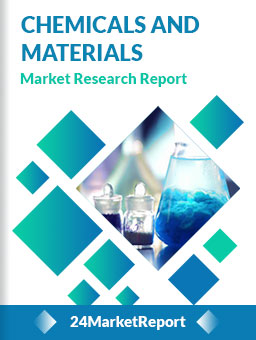
Download FREE Report Sample
Download Free sampleFlame retardant chemicals are additive used to increase fire resistance of materials when they are exposed to ignition or fire spread. Non-halogenated flame retardant chemicals are based on aluminum, magnesium, boron, antimony-based oxides and hydroxides, phosphorus, nitrogen, etc. These chemicals are environment-friendly as compared to halogenated flame retardant chemicals, and can be used in polymers as an additive to increase the fire resistance.
Non-Halogenated Flame Retardants Market aims to provide a comprehensive presentation of the global market for Non-Halogenated Flame Retardants, with both quantitative and qualitative analysis, to help readers develop business/growth strategies, assess the market competitive situation, analyze their position in the current marketplace, and make informed business decisions regarding Non-Halogenated Flame Retardants. Non-Halogenated Flame Retardants Market contains market size and forecasts of Non-Halogenated Flame Retardants in global, including the following market information:
Global Non-Halogenated Flame Retardants Market Revenue, 2018-2023, 2024-2030, ($ millions)
Global Non-Halogenated Flame Retardants Market Sales, 2018-2023, 2024-2030, (K MT)
Global top five Non-Halogenated Flame Retardants companies in 2022 (%)
The global Non-Halogenated Flame Retardants market was valued at US$ 2059.1 million in 2022 and is projected to reach US$ 2783.9 million by 2029, at a CAGR of 4.4% during the forecast period. The influence of COVID-19 and the Russia-Ukraine War were considered while estimating market sizes.
Growing infrastructure activities in APAC countries is driving the market. Owing to emergent business opportunities in countries, such as India, China, Malaysia, and Indonesia. Asia-Pacific is gradually becoming a new business hub. The demand for high-rise buildings and business infrastructure is increasing in this region. The rise in tourism is expected to increase, which will augment the demand for non-halogenated flame retardant chemicals.
We surveyed the Non-Halogenated Flame Retardants manufacturers, suppliers, distributors and industry experts on this industry, involving the sales, revenue, demand, price change, product type, recent development and plan, industry trends, drivers, challenges, obstacles, and potential risks.
Total Market by Segment:
Global Non-Halogenated Flame Retardants Market, by Type, 2018-2023, 2024-2030 ($ Millions) & (K MT)
Global Non-Halogenated Flame Retardants Market Segment Percentages, by Type, 2022 (%)
Aluminum Hydroxide
Phosphorous Based
Global Non-Halogenated Flame Retardants Market, by Application, 2018-2023, 2024-2030 ($ Millions) & (K MT)
Global Non-Halogenated Flame Retardants Market Segment Percentages, by Application, 2022 (%)
Construction
Electrical
Transportation
Chemical
Others
Global Non-Halogenated Flame Retardants Market, By Region and Country, 2018-2023, 2024-2030 ($ Millions) & (K MT)
Global Non-Halogenated Flame Retardants Market Segment Percentages, By Region and Country, 2022 (%)
North America
US
Canada
Mexico
Europe
Germany
France
U.K.
Italy
Russia
Nordic Countries
Benelux
Rest of Europe
Asia
China
Japan
South Korea
Southeast Asia
India
Rest of Asia
South America
Brazil
Argentina
Rest of South America
Middle East & Africa
Turkey
Israel
Saudi Arabia
UAE
Rest of Middle East & Africa
Competitor Analysis
The report also provides analysis of leading market participants including:
Key companies Non-Halogenated Flame Retardants revenues in global market, 2018-2023 (Estimated), ($ millions)
Key companies Non-Halogenated Flame Retardants revenues share in global market, 2022 (%)
Key companies Non-Halogenated Flame Retardants sales in global market, 2018-2023 (Estimated), (K MT)
Key companies Non-Halogenated Flame Retardants sales share in global market, 2022 (%)
Further, the report presents profiles of competitors in the market, key players include:
Nabaltec
Huber Engineered Materials
BASF
ICL
DAIHACHI Chemical Industry
Outline of Major Chapters:
Chapter 1: Introduces the definition of Non-Halogenated Flame Retardants, market overview.
Chapter 2: Global Non-Halogenated Flame Retardants market size in revenue and volume.
Chapter 3: Detailed analysis of Non-Halogenated Flame Retardants manufacturers competitive landscape, price, sales and revenue market share, latest development plan, merger, and acquisition information, etc.
Chapter 4: Provides the analysis of various market segments by type, covering the market size and development potential of each market segment, to help readers find the blue ocean market in different market segments.
Chapter 5: Provides the analysis of various market segments by application, covering the market size and development potential of each market segment, to help readers find the blue ocean market in different downstream markets.
Chapter 6: Sales of Non-Halogenated Flame Retardants in regional level and country level. It provides a quantitative analysis of the market size and development potential of each region and its main countries and introduces the market development, future development prospects, market space of each country in the world.
Chapter 7: Provides profiles of key players, introducing the basic situation of the main companies in the market in detail, including product sales, revenue, price, gross margin, product introduction, recent development, etc.
Chapter 8: Global Non-Halogenated Flame Retardants capacity by region & country.
Chapter 9: Introduces the market dynamics, latest developments of the market, the driving factors and restrictive factors of the market, the challenges and risks faced by manufacturers in the industry, and the analysis of relevant policies in the industry.
Chapter 10: Analysis of industrial chain, including the upstream and downstream of the industry.
Chapter 11: The main points and conclusions of the report.

Speak to our Custom Research Team and get the Custom Research in a budget
Custom ResearchFrequently Asked Questions ?
A license granted to one user. Rules or conditions might be applied for e.g. the use of electric files (PDFs) or printings, depending on product.
A license granted to multiple users.
A license granted to a single business site/establishment.
A license granted to all employees within organisation access to the product.
Upto Working 24 to 48 hrs
Upto 72 hrs max - Weekends and Public Holidays
Online Payments with PayPal and CCavenue
Wire Transfer/Bank Transfer
Hard Copy




 Industry Market Size
Industry Market Size SWOT Analysis
SWOT Analysis Industry Major Players
Industry Major Players Revenue Forecasts
Revenue Forecasts Historical and Forecast Growth
Historical and Forecast Growth Profitability Analysis
Profitability Analysis
























